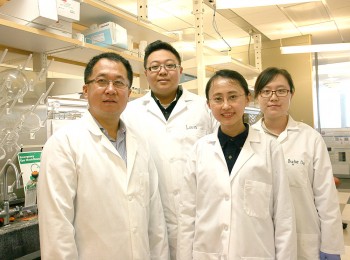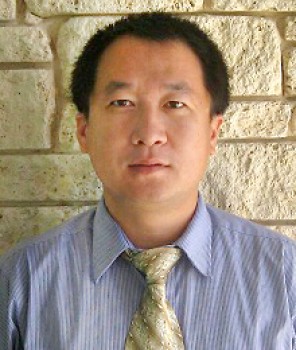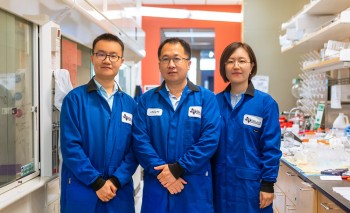Ph.D. - Department of Chemistry and Biochemistry
Georgia Institute of Technology - 2005

Jie Zheng
Distinguished Chair in Natural Sciences and Mathematics
Professor of Chemistry and Biochemistry
Affiliated Professor of Bioengineering and Mechanical Engineering
Adjunct Professor of Urology at UTSW Medical Center
Professional Preparation
B.S. - Department of Chemistry
Inner Mongolia University - 1994
Inner Mongolia University - 1994
Research Areas
Research Interests
Our research is centered on investigating fundamental structure-property relationships of nanomaterials at bulk and single molecular level and exploring their applications in bioimaging, catalysis and energy conversionPublications
pH-Responsive Self-Assembly of Renal-Clearable Nanoparticles in the Kidneys: One Assembly per Endosome 2025 - Journal Article
Blood Retention and Kidney Clearance of Renal‐Clearable Gold Nanoparticles Strongly Correlate with Renal Injury Biomarkers 2025 - Journal Article
Fertile Ground for Mathematical Modeling: Therapeutic and Diagnostic Nanoparticle Transport in the Glomerulus 2025 - Journal Article
Nanoparticle Transport in Proximal Tubules with Rhabdomyolysis‐Induced Necrosis 2025 - Journal Article
Physiological principles underlying the kidney targeting of renal nanomedicines 2024 - Journal Article
Gold Nanoparticle Transport in the Injured Kidneys with Elevated Renal Function Biomarkers 2024 - Journal Article
Nanoparticle Transport in Proximal Tubules with Rhabdomyolysis‐Induced Necrosis 2024 - Journal Article
Proximal tubules eliminate endocytosed gold nanoparticles through an organelle-extrusion-mediated self-renewal mechanism 2023 - Journal Article
Appointments
Postdoctoral Fellow
Harvard University [2005–2008]
Harvard University [2005–2008]
Research Assistant
Georgia Institute of Technology [2002–2005]
Georgia Institute of Technology [2002–2005]
Projects
Material Research Society spring conference(Invited talk)
2005–2005 J. Zheng, R.M. Dickson, Material Research Society spring conference, San Francisco, CA , March, 2005 (Invited talk)Additional Information
Honors and Awards
- Honored for individual accomplishment, College of Science, Georgia Tech. 4/2005
- Material Research Society Graduate Student Award 3/2005
- House-Flashka-Ashby graduate student award, Georgia Tech. 10/2004
Patents
- X.W.Zhuang, J. Zheng, "GRANULAR NANOPARTICLES HAVING BRIGHT FLUORESCENCE AND GIANT RAMAN ENHANCEMENTS " Patent applied for, 2008
- R.M. Dickson, J. Zheng, "Nano-sized optical fluorescence labels and uses thereof", Patent issued WO2004003558 (licensed by Invitrogen), 2005
- Z.N. Bao, J. Zheng, "Fom1ing closely spaced electrodes", Patent issued, US2005014357, 2005
News Articles
Technique May Improve Understanding, Detection of Kidney Disease
 UT Dallas scientists are developing an innovative research technique that could help urologists better understand the early stages of kidney disease.
UT Dallas scientists are developing an innovative research technique that could help urologists better understand the early stages of kidney disease.Dr. Jie Zheng, associate professor of chemistry and biochemistry at UT Dallas, and his colleagues have combined tiny gold nanoparticles with a technique called in vivo near-infrared fluorescence imaging to study early stage kidney disease in a live animal model.
Nanoparticle Study Attracts State Cancer Research Funds
 Dr. Jie Zheng, a member of the chemistry faculty at UT Dallas, has received more than $1.2 million in funding from the Cancer Prevention and Research Institute of Texas (CPRIT) for work on safer nanoparticles that can adhere to prostate tumor cells, making earlier diagnosis possible.
Dr. Jie Zheng, a member of the chemistry faculty at UT Dallas, has received more than $1.2 million in funding from the Cancer Prevention and Research Institute of Texas (CPRIT) for work on safer nanoparticles that can adhere to prostate tumor cells, making earlier diagnosis possible.Dr. Zheng, assistant professor of chemistry, explores biomedical applications of tiny gold nanoparticles that respond to the acidic microenvironments of prostate tumors. When introduced in the body, the particles can take advantages of a slight difference in pH between the tumors and normal tissue, essentially lighting up cancer cells to which they adhere, making them easier to detect with a variety of medical imaging tools.
Chemists Close Gap in Making Nanomedicines Safer, More Efficient
 Dr. Jie Zheng believes he’s turned a barrier into a bridge when it comes to nanomedicine implementation.
Dr. Jie Zheng believes he’s turned a barrier into a bridge when it comes to nanomedicine implementation.The professor of chemistry and his research team at The University of Texas at Dallas have demonstrated that nanomedicines can be designed to interface with a natural detoxification process in the liver to improve their disease targeting while minimizing potential side effects.
Their study, published July 15 in Nature Nanotechnology, indicates a path to making nanomedicine safer and more efficient.
Accolades: Chemist Receives AIMBE Honor; UTD Earns Gold for Sustainability
 Accolades is an occasional News Center feature that highlights recent accomplishments of The University of Texas at Dallas faculty and students. To submit items for consideration, contact your school’s communications manager.
Accolades is an occasional News Center feature that highlights recent accomplishments of The University of Texas at Dallas faculty and students. To submit items for consideration, contact your school’s communications manager. Dr. Jie Zheng, professor of chemistry, has been elected to the College of Fellows of the American Institute for Medical and Biological Engineering (AIMBE). He is among 156 new fellows announced March 24.
Zheng was elected for “his outstanding contributions to fundamental understandings of in vivo nanoparticle transport and the development of renal clearable nanomedicines,” according to the institute.
Dr. Jie Zheng Receives Nearly $1.5 Million from NIH
 The National Institutes of Health awarded Dr. Jie Zheng $1,451,573 for his research on Noninvasive Monitoring of Hepatic Glutathione Depletion through Blood Test. The project focuses on the use of gold nanoparticles to detect acute liver damage early through simple blood tests. Dr. Zheng’s groundbreaking research could replace current methods that are more invasive for monitoring and diagnosing liver disease.
The National Institutes of Health awarded Dr. Jie Zheng $1,451,573 for his research on Noninvasive Monitoring of Hepatic Glutathione Depletion through Blood Test. The project focuses on the use of gold nanoparticles to detect acute liver damage early through simple blood tests. Dr. Zheng’s groundbreaking research could replace current methods that are more invasive for monitoring and diagnosing liver disease.